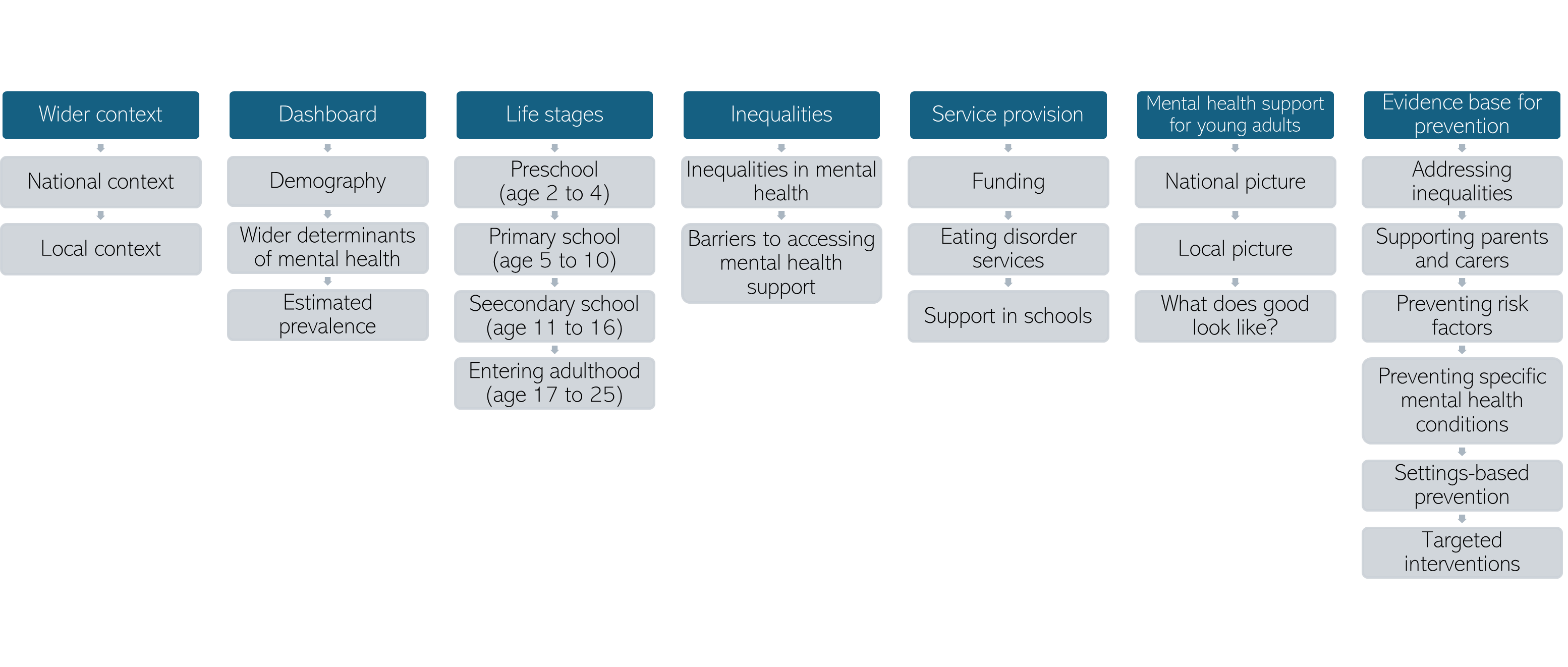Note on terminology: Children are defined as individuals aged 2 to 14, young people as 14- to 25-year-olds. Young adults are defined 18- to 25-year-olds, a subset of the young people (Pari, 2022).
This chapter explores the mental health needs of children and young people in Cambridgeshire and Peterborough across four stages in their lives: preschool, primary school, secondary school and entering adulthood. Experiencing poor mental health can have a substantial impact on young people’s lives, including on relationships, educational outcomes, employment and life expectancy. Half of all mental health conditions become established before age 14, and 75% by age 24 (Kessler et al., 2005), although treatment does not usually start until many years later (Kessler et al., 2007). This highlights the importance of preventing mental health conditions, which is also covered in this chapter.
This chapter builds on the Cambridgeshire and Peterborough’s children and young people’s mental health strategy 2022 – 2025, and covers:
Figure 1: Structure of the children and young people’s chapter of the mental health needs assessment
- Local and national context of children and young people’s mental health
- Children and Young People Mental Health Dashboard
- Lifestages: preschool (age 2 to 4); primary school (age 5 to 10); secondary school (age 11 to 16); and entering adulthood (age 17 to 25).
- Groups facing inequalities in mental health and barriers to accessing mental health support
- Service provision, with a focus on funding, eating disorder services and support in schools
- Mental health support for young adults – Transitions
- The evidence base for prevention of mental ill-health in children and young people
This chapter can also be viewed as a pdf.
Priorities for future work
The Children and Young People’s Mental Health Strategy identified key system priorities for Cambridgeshire and Peterborough (Cambridgeshire and Peterborough Integrated Care System, 2022c). In alignment with this, this mental health needs assessment has identified areas of ongoing work to develop the local understanding of mental health need:
General
- Work to develop a learning health system for children and young people’s mental health
- Investigate the overlap between physical and mental health conditions in children and young people locally, and the integration of physical and mental healthcare
- Work towards understanding every service across the THRIVE model, including in terms of: service provision, workforce, and equality of access. For example:
- Are crisis and acute services for children and young people equitably provided across the county?
Evidence-base for prevention
- Assess local provision against the evidence-base for preventing adverse childhood experiences
- Investigate what preschool education programmes are in place to promote good mental wellbeing
Life stages
- Explore the lower than average levels of school readiness and communication and language skills in reception children in Peterborough, with the aim to identify how this could be addressed
- Understanding approaches to the earlier identification of children experiencing difficulties with their mental health
- Strengthen the whole-school approach to mental health across the county and address the barriers to this being implemented effectively
- Map out the local mental health prevention and early support offer for young people who are not in employment, education or training (NEET)
- Map local support for children in care against NICE guidelines around interventions to promote physical, mental, and emotional health and wellbeing of looked-after children, young people and care leavers
- Investigate the number of children and young people who are in home education in Cambridgeshire and Peterborough, including the proportion with special education needs (SEND)
Inequalities
- Assess the mental health needs locally of children and young people who are at risk of, or experience, criminal exploitation
- Replicate this analysis of inequities in children and young people’s mental health services for Cambridgeshire and Peterborough Integrated Care system
Service provision
- Continue work to understand whole pathways across children’s mental health services, including NHS, voluntary sector and local authority support (in terms of access, outcomes, inequalities and workforce)
- Build on the work showing that local per head spending on mental health services, and some other support services, for children and young people are lower than the national and regional average.
- Understand the reasons behind the increase in referrals to YOUnited over recent years, including analysing referral pathways
- Develop a plan to increase the proportion of local schools with a senior mental health lead
- Better understanding the waiting times for local eating disorder services
- There is feedback that avoidant restrictive food intake disorder (ARFID) contributed to the rises in eating disorders over the pandemic. Explore this and investigate the service provision for people with ARFID.
- Explore the benefits and risks of increasing the use of digital interventions to meet mental health needs
- Evaluating the impact of increasing the use of single session therapy (SST)
Transitioning from child to adult mental health services
- There is clear evidence and an agreement that there should be a 0-25 model for mental health support, as described in the NHS Long Term Plan. Develop a roadmap with system partners to making this happen, with key deliverables at different stages.
- Evaluate local eating disorder services against the East of England self-assessment checklist for transition standards

